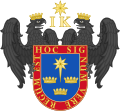History
On December 22, 1574, when viceroy Francisco de Toledo reorganised the Indian Corregimientos , which had been created by governor Lope García de Castro in 1565 by appointing native judges, he ordered that the corregimientos of Huarochirí, Huaylas, Ica, Jauja, Arnedo, Cajatambo and Canta depended on the ordinary mayors of the Cabildo of Lima. All of them in the district of the Real Audiencia of Lima. In 1576, Cañete was created, separating it from Ica and the city of Lima. In 1591 the Cercado de Lima was separated from Lima and Cañete. In the 17th century, the port of Callao began to have a military governor appointed by the king. [2]
The intendancy system was established in the Viceroyalty of Peru by royal order of August 5, 1783. The first intendant of Lima (who took office in 1784) was the visitor general Jorge Escobedo y Alarcón [ es ], [3] approved by the king on January 24 of 1785. In 1787, the mayor's office was left in the hands of the viceroy until 1805 when Juan María Gálvez, then intendant of Huancavelica, took office, being named on September 22, 1804. [4] In 1809, the intendancy was suppressed, [5] although by 1811 it had been reestablished with Galvez back in office. [6]
The parts of the intendancy occupied by the Liberating Expedition of Peru were replaced by the Department of the Coast on 12 February 1821, proclaimed by General Jose de San Martin through the Reglamento Provisional during the Peruvian War of Independence, [1] and later in its entirety with the creation of the Department of Lima by the Provisional Statute, promulgated on October 8, 1821. [7]
This page is based on this
Wikipedia article Text is available under the
CC BY-SA 4.0 license; additional terms may apply.
Images, videos and audio are available under their respective licenses.

